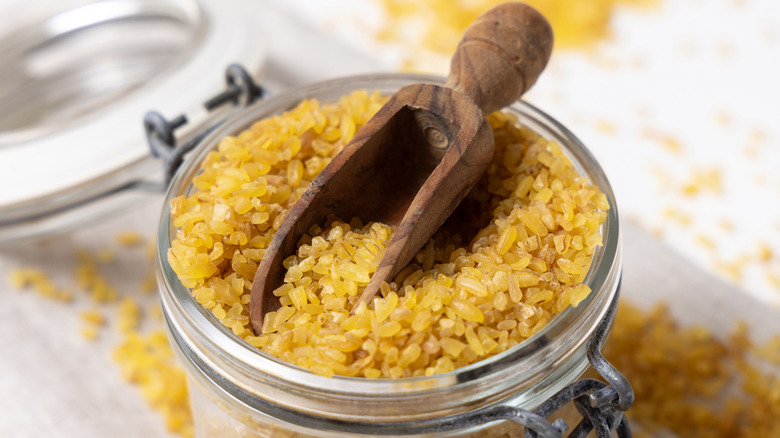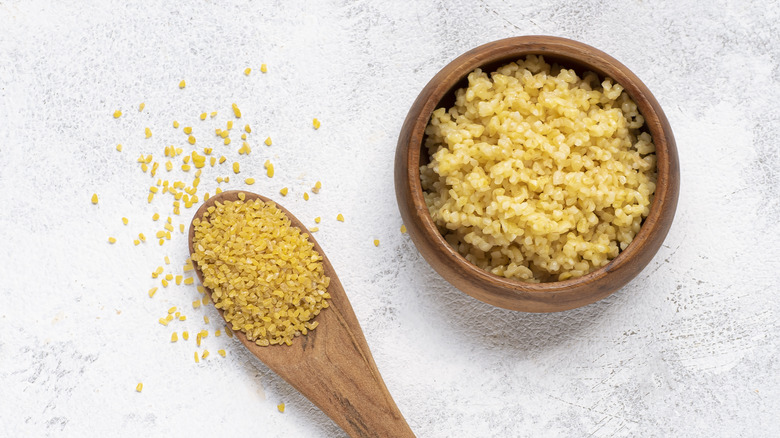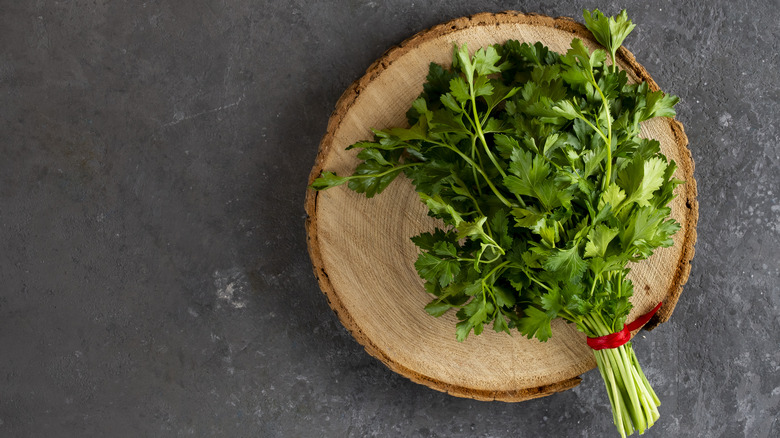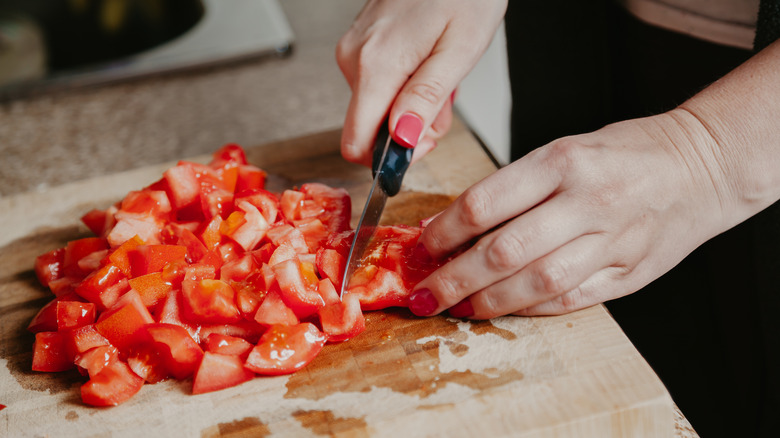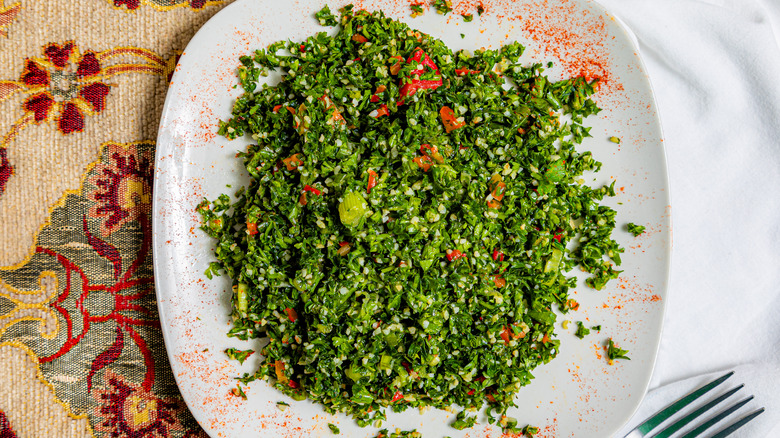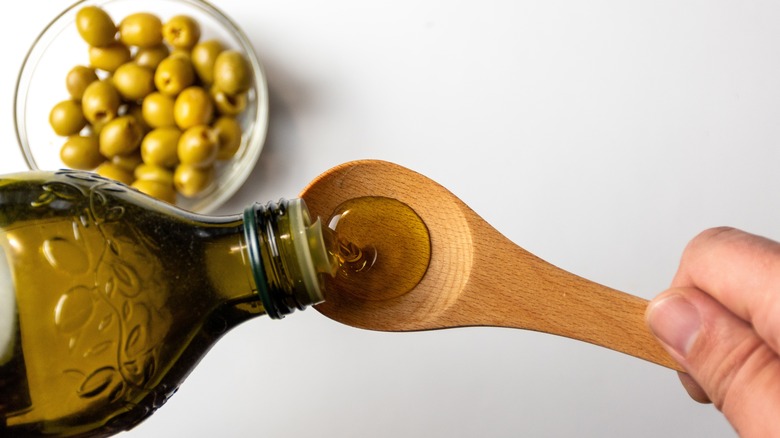10 Mistakes Everyone Makes With Tabbouleh
During the hot days of summer, it's a good idea to have a few no-cook meal options up your sleeve. Choosing not to turn on your stove or oven can mean making a lot of salads, but that doesn't have to be boring when you know how to make a salad like tabbouleh. This tangy and fresh salad is bright, bursting with flavor, and unlike other salads you may already have in your repertoire. Popular in Levantine cuisine, this salad is eaten cold, as a mezze side dish or simply on its own. It may look like it has many ingredients, but it only uses a handful, and is easily dressed with some olive oil and lemon juice. While you can always customize the ingredients according to your preferences and what you have available, it's usually made with a base of fresh parsley, tomatoes, and bulgur wheat.
As a professional cook and recipe developer with Middle Eastern heritage, I rely on tabbouleh to impress friends and clients. Even those who say they aren't a fan of tabbouleh end up enjoying it. This is likely because they've tried a store-bought version or one that hasn't been prepared with the right ingredients, method, or preparation. Tabbouleh is not a hard salad to track down; however, they're not all made equally. For such a deceptively simple salad, there are plenty of ways people go wrong with it. Luckily, once you know what to do, you can get it right every time. Here are some mistakes everyone makes with tabbouleh.
Thinking any type of grain will work the same
Perhaps one of the main mistakes people make with tabbouleh is using the wrong grain. Most people think the grain is meant to be couscous when, in fact, a traditional tabbouleh is made with bulgur wheat. Bulgur wheat has, in my opinion, just the right amount of bite needed to give a tabbouleh the right texture. Couscous can tend to get too soft, and even mushy. Bulgur wheat is a little less common, and people might be intimidated to try it; however, you can find it in any major grocery store, and its preparation couldn't be easier.
Another thing people might do is substitute bulgur wheat with quinoa. This is understandable for people who are intolerant to gluten, but still want to enjoy a tabbouleh. For everyone else, though, I recommend using bulgur wheat, as it's going to be a more authentic experience. I've been seeing more health blogs and influencers push a quinoa-based tabbouleh because quinoa is more protein-rich than bulgur wheat. Even though it's become a health trend to try to increase the protein content of meals, it doesn't work well for everything. You really shouldn't be eating tabbouleh for protein anyway. You want to enjoy this salad in its best form, and it's already healthful and nutritious without needing to be another way to eat protein.
Using the wrong size of grain
People also tend to get the grain size wrong. If you're a newbie to using bulgur wheat, there is the risk of not knowing that it's available in various sizes. For tabbouleh, you want to go for a small cut of grain — the smaller the better. This is because it's not meant to be a grain-centered salad like people might assume. The grains serve the purpose of soaking up the dressing and adding some texture, but otherwise, aren't meant to be the star of the show. If you want to get this right the first time, then pay a visit to a Middle Eastern grocery store. I've always found that Middle Eastern brands of bulgur wheat are always sold from very fine to coarse. They even follow a particular numbering from one to four. One, being very fine, and four, being coarse. I choose either one or two for tabbouleh.
The size of the grain will determine how to prepare it. For very fine to fine bulgur wheat, you only need to soak the grains to rehydrate them. I've found that you don't even need to use hot water. With coarser grains, however, you might have to soak with boiling water, or even boil them in a pot. Another pitfall that people fall into is buying coarse bulgur wheat and ending up with crunchy or undercooked bulgur, because they've followed a tabbouleh recipe that instructs them to soak it only. Whichever type you use, make sure to follow the package instructions to get it right.
Forgetting parsley
In many Middle Eastern households, tabbouleh is known as a parsley salad. There is simply no tabbouleh without parsley. Now, I don't often come across such a thing, but that doesn't mean it's never happened. I've seen tabbouleh that leaves out parsley altogether and uses cilantro and other herbs instead. Now, as a big cilantro fan (and someone who doesn't even love parsley), I can say that making tabbouleh without parsley is an almost unforgivable mistake. It's certainly fine to add cilantro and other herbs, along with the parsley, but parsley cannot be replaced.
Don't worry if you or your loved ones don't like parsley. When made right, tabbouleh can convert any person who hates parsley into liking it. It's just one of the best preparations for this underrated herb, and it truly celebrates it. The combination of flavors in the salad also beautifully balances out parsley's sharpness, mellowing it out while highlighting its herbaceousness. You can substitute any of the other ingredients that you like (even the grain if you must), but you shouldn't substitute parsley. While I have a strong preference for flat-leaf parsley, you can also use the curly variety. Then, add a handful of fresh mint too, and your tabbouleh will soar to new heights.
Getting the ratio of herbs to grains wrong
As mentioned before, tabbouleh is all about the fresh herbs, with the grains playing a supporting role. A tabbouleh should be mostly green, with a little bit of yellow grain in it. Some people might even leave out the bulgur altogether. However, many people, from cafes and professional kitchens to delis and grocery stores, get this one thing wrong, time and time again. It's so common to find tabbouleh that's mostly yellow, with specks of green in it, as people incorrectly think that the grains are the base of the salad. This is often the culprit of why people think they dislike tabbouleh. In truth, there are regional variations and differences across the Levant about the ratio of herbs to grains. And still, you'll always find that an authentic tabbouleh has way more parsley than bulgur wheat than you think.
Middle Eastern cuisine is herb-heavy, and it's pretty common for different dishes to have large volumes of fresh herbs. So if you're making tabbouleh, opt for a large bunch of fresh parsley, because the regular grocery store half-ounce packet is not going to cut it. The trick to using a large volume of herbs is in how you cut them. Cutting your herbs too coarsely will result in a tabbouleh that's a chore to eat. You need to chiffonade the parsley as finely as you're able to, to get the ideal texture for your salad. It's the most labor-intensive part of the salad, so use your elbow grease and get into it.
Including cucumber
It's very common to find cucumber in tabbouleh salads across the globe. However, this isn't an ingredient typically included in traditional tabbouleh. Of course, every household does it their own way, and everybody is allowed to make food and recipes with their twists. But if you're looking to make tabbouleh as it was intended, then cucumbers need to be left out.
Cucumbers are a great vegetable to use in all sorts of salads, but in tabbouleh, they can make your salad a bit too watery. They can also detract, or water down, the other zingy flavors of lemon juice and parsley, without adding much flavor. I've tried tabbouleh both with and without cucumber, and I find that the taste of the tabbouleh without cucumber is more "pure" and has more character. That being said, you're free to always customize recipes according to what you like to eat, and if that includes cucumber, then go for it.
Using overripe tomatoes
Tomatoes are a key ingredient in tabbouleh. They are the only ingredient that brings some sweetness to the salad, and this is really important in the balance of the dish. They also add a little bit of red "relief" to the otherwise green salad. Other than how you dice or chop them, there's no way you can go wrong, other than using tomatoes that are overripe. Overripe tomatoes tend to be softer and mushier, and in a tabbouleh, you want tomato pieces that hold their own and help keep the salad crisp.
While overripe tomatoes can be sweeter or more intense in flavor, that's not a payoff that's worth having a tabbouleh that's too watery and soft. That's why it's always a good idea to reach for your newer or firmer tomatoes. They give the salad just enough sweetness while still adding to the texture. Some people even recommend removing the tomato seeds and only using the fleshy part, but as a lazy cook (and someone who doesn't like food waste), I don't think this is necessary. Instead, use harder, or just ripe tomatoes, and you can use them whole. Just use a sharp knife and chop them up into relatively small pieces, without pressing down on them as you cut. This way, you won't squeeze out their juice, and they'll stay crisp and juicy in your tabbouleh.
Underestimating how much dressing you need
To achieve all the tangy brightness of a delicious tabbouleh, it's important to dress it adequately. You can have all the freshest ingredients, perfectly prepared, but then end up with a tabbouleh that's dry or bland in the final hour. This will likely be due to adding too little salad dressing. Many salads in Middle Eastern cooking are generously dressed, and tabbouleh is no different. With a few basic ingredients, the dressing couldn't be simpler. No need to buy any specific dressing or ingredients. All you need is olive oil, lemon juice, and a little bit of salt.
So, how much dressing should you add? With many traditional recipes that have been passed down orally and visually, many cooks tend to eyeball. It's difficult to get exact measurements, and obviously, it also depends on the volume of your salad. A good rule of thumb is to make sure everything is well coated and glossy, a sign that the olive oil has reached all the components of the salad. However, you don't want to overdress either, so don't just blindly glug in the oil. Then, the only real advice is to taste. Squeeze in some lemon juice and lightly sprinkle on some salt. Give everything a mix and then taste it. If it tastes a little on the bland side, squeeze in a bit more juice and another pinch of salt. Repeat this until the salad tastes good to you.
Using sub-par olive oil
Given that the dressing for a tabbouleh uses so few ingredients, you want to make sure you're using good-quality olive oil. Understandably, olive oil can get people stressed out. There are so many brands, in different types of bottles and with different origins. If you're a newbie to using olive oil, it makes sense if you're intimidated by it. There are two simple rules I follow. Always choose an olive oil in a glass bottle (not plastic), and opt for extra virgin olive oil for your salads. As someone who has grown up with a cuisine that uses olive oil as one of our main sources of fat, I can assure you that a subpar olive oil can ruin the taste of a tabbouleh. It's not only there to lubricate the salad, but it is actually providing the backbone of the flavor component, too.
Like with most things in life, it's also about your taste preference, and this can only come from trying different olive oils until you find one you like the taste of. You can also get some insights and advice from reading our ranking of the best olive oils to use for dressing your salads. Lastly, keep in mind that olive oil does go rancid and isn't something that will last for years in your pantry. If you're not going to use it regularly, don't buy a large bottle. If you've had a bottle for a while, give it a taste first, as rancid olive oil will instantly ruin your meal.
Forgetting to let your tabbouleh marinade for a while
The best part about tabbouleh is that it gets better with time. Unlike most salads that don't hold up well as leftovers, tabbouleh doesn't tend to get soggy and gets even more flavorful in your fridge. This makes it perfect for making ahead or as a meal planning option for the week. This can also work against you if you plan to make and eat your tabbouleh right away. It will taste fine, but the best method for a more flavorful tabbouleh is to let it marinate in your fridge. Instead of using many fancy ingredients, a great tabbouleh is simply one that's been given some time.
Unlike other salads, tabbouleh isn't full of water-packed vegetables. That's another reason why you shouldn't add cucumber or use overripe tomatoes, because all of these veggies leak water and get soggy over time. Instead, tabbouleh is mostly made up of parsley, a herb that can be a chore to chew if you're eating it in large quantities. Giving parsley time to marinate helps to mellow it out and make it lighter in texture and flavor. Give your tabbouleh at least a couple of hours in the fridge before serving it. While I find that the best tabbouleh is one that I've made the day before, you can get away with at least two hours. This gives it a chance to "set," and the flavors to intertwine and seep into each other.
Keeping it unrefrigerated
Because tabbouleh isn't a salad that easily gets soggy, it's a popular choice for taking to potlucks, beach picnics, or even outdoor barbecues. I've had my fair share of tabbouleh in a Tupperware, at the beach, or at a friend's summer gathering. It's fresh, light, and appetizing. But the secret to its greatness is that it needs to be eaten cold. Tabbouleh that's been left at room temperature, or even worse, has gone warm in the sun, is just not good. It needs to be kept refrigerated to the last minute so that it's at its best.
If you've gone through all the effort to make a good tabbouleh and have put in the labor of fine chopping everything, dressing it well, and letting it marinate, don't ruin it by serving it warm. So, if you're planning to take it to a picnic or somewhere outdoors, store it in an insulated container and take it in a cooler box or bag. It's a little more effort, but it's worth it so that you can enjoy everything a tabbouleh has to offer. If my experiences are anything to go by, your friends will be most impressed by the result, and people will likely ask you for all your secrets.

